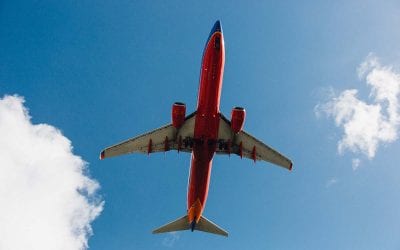American Airlines AURA tool to reassign connecting flights hurts passengers who arrive in time for an original connecting flight and causes massive delays and problems.
 Last week, a good friend came back from Hawaii on American Airlines. Her flight left 45 minutes late due to maintenance paperwork. Flying to the Dallas-Fort Worth International Airport (DFW), the pilots gained back all but 25 minutes. My friend had a connecting flight home from DFW, but a program, AURA, that can reassign connecting flights had been started prematurely.
Last week, a good friend came back from Hawaii on American Airlines. Her flight left 45 minutes late due to maintenance paperwork. Flying to the Dallas-Fort Worth International Airport (DFW), the pilots gained back all but 25 minutes. My friend had a connecting flight home from DFW, but a program, AURA, that can reassign connecting flights had been started prematurely.
Running all the way from her arrival gate, she made it to her connecting flight gate approximately 15 minutes before its scheduled departure. Standby passengers had already filled her seats.
Having worked in the industry, she reminded the gate agents that they weren’t supposed to close out a flight if they could visually see passengers running to catch the flight. She and her companions got the last seats on the flight and got home on time, though the seats were among the worst on the plane. With her flight’s initial delay, it turns out that on American Airlines, she was lucky to board her scheduled connecting flight at all.
Too many AA passengers miss connecting flights based on a premature AURA program that can reassign connecting flights
These days, too many American Airlines passengers miss their connecting flights despite getting to the flight’s gate in time to board.
The problem is American’s AURA system, which rolled out last summer. AURA stands for Automated ReAccommodation.
AURA is a tool that looks at flights that are canceled or delayed and rebooks passengers on other flights proactively. For delayed flights, the tool doesn’t wait until passengers have landed or are close to landing, so they know if passengers do or don’t actually have a reasonable chance of getting to their gates in time to make their connecting flight. The computerized system predictively handles flight delays to rebook. Its predictive quality is the AURA problem.
According to American Airlines, “AURA utilizes a concept called discovered inventory, in which it identifies passengers that are certain to misconnect and utilizes that available inventory for protecting other passengers who may need that space.”
AURA is supposed to rebook passengers only if they are “certain” to miss their connecting flights, not if they “might” miss them.
The AURA system predicted that my friend and her traveling companions were “certainly” not going to arrive at DFW in time to make their connecting flight home, However, AURA was wrong, as it has been many times.
AURA is canceling passengers’ flights and rebooking them on new flights, some within hours, others the next day. It’s doing that despite the fact that they haven’t yet missed their connecting flight and may actually not miss it.
Late last year, a reader tried to make a connecting flight through Chicago O’Hare International Airport. His initial flight was delayed by a half hour. The AURA system reassigned him to a much later flight out of Chicago. It clearly didn’t consider that his connecting flight was delayed by about an hour. He got to its gate before pre-boarding commenced but still lost his seat in first class, which had already been assigned to another passenger. He got on the flight but was in an economy middle seat.
Frankly, too often, AURA’s predictions don’t seem to have any basis in reality.
Gate agents have told me that the AURA “go/no-go” time predictor to decide if passengers will arrive at the connecting airport is 45 minutes delay. I don’t know if that’s true, as readers have said that they’ve been on planes that left 35 to 40 minutes late with pilots stating they’d make up most of the delay, yet AURA took their seats and reassigned them to others, rebooking them on flights much later that day or sometimes the following day. Then, as you can guess, they arrived in time to board their original connecting flight, but their tickets were already canceled.
According to American Airlines’ website page, Flying with American, you only have to be at the gate, ready to board your connecting flight “15 minutes before departure on domestic flights.”
AURA’s predictive algorithm is deficient.
It appears as though AURA’s predictive algorithm is substantially based on a deficient parameter. The “go/no-go” deadline doesn’t take into account a variety of factors. Much of the time, pilots overcome all or a significant portion of delayed departures. If passengers hurry and flight crews let connecting passengers get off first, like they often do, many if not most passengers can get to their connecting flight gate in 15 minutes or less from the time they depart their first flight.
American further states on their website’s page, Boarding Process, that seats on American Airlines flights shouldn’t be reassigned 15 minutes before departure. Clearly, under AURA, seats are being assigned at least as long as 45 minutes before passengers’ connecting flights departure times. Once a seat has been reassigned, American will not reverse the reassignment, even when you’re at the gate on time to board, according to American’s own rules and even when the reassignment results in a substantial seat type downgrade, as it has for readers who have sent me their AURA stories.
AURA’s rebooking of passengers — even when the passengers arrive for their connecting flight on time — is no different than being involuntarily denied boarding.
There’s another problem with AURA. To me, it’s a biggie. If AURA reassigns a passenger’s seat and doesn’t rebook them on their original connecting flight, that’s tantamount to “involuntary denied boarding” and requires compensation even if the passenger is booked on another flight to their destination within hours. American is not providing such compensation, according to family, friends and readers.
If American doesn’t fix AURA, then the U.S. Department of Transportation should require them to fix it or eliminate it.
I strongly suggest that American Airlines make these changes to the AURA program:
1. AA must substantially improve the AURA algorithm to account for many more variables than they are likely considering: proximity of the original flight arrival gate and the connecting flight departure gate; the ability of the pilots of the original flight to make up time; and real-time flight updates and the on-time status of the connecting flight, etc.
2. The airline must choose a substantially shorter “go/no-go” time than 45 minutes. A half-hour would be a good start.
3. American should allow passengers to opt out of AURA. At least their AAdvantage Platinum Pro and higher members should be able to opt-out.
4. Any passenger arriving at their connecting flight gate within the time designated by American Airline’s rules should be compensated, as passengers are involuntarily denied boarding.
It’s time for American Airlines to voluntarily reverse the poor judgments that created AURA and fix the tool. The U.S. Department of Transportation must step in and require American Airlines to change the program because it regularly unfairly hurts its customers.
(Image: American Airlines A319 landing at Philadelphia International Airport. Copyright © 2018 NSL Photography. All Rights Reserved.)
READ ALSO:
7 mistakes to avoid at TSA airport security checkpoints
Car rental companies turn to old rental scams
After many years working in corporate America as a chemical engineer, executive and eventually CFO of a multinational manufacturer, Ned founded a tech consulting company and later restarted NSL Photography, his photography business. Before entering the corporate world, Ned worked as a Public Health Engineer for the Philadelphia Department of Public Health. As a well known corporate, travel and wildlife photographer, Ned travels the world writing about travel and photography, as well as running photography workshops, seminars and photowalks. Visit Ned’s Photography Blog and Galleries.



